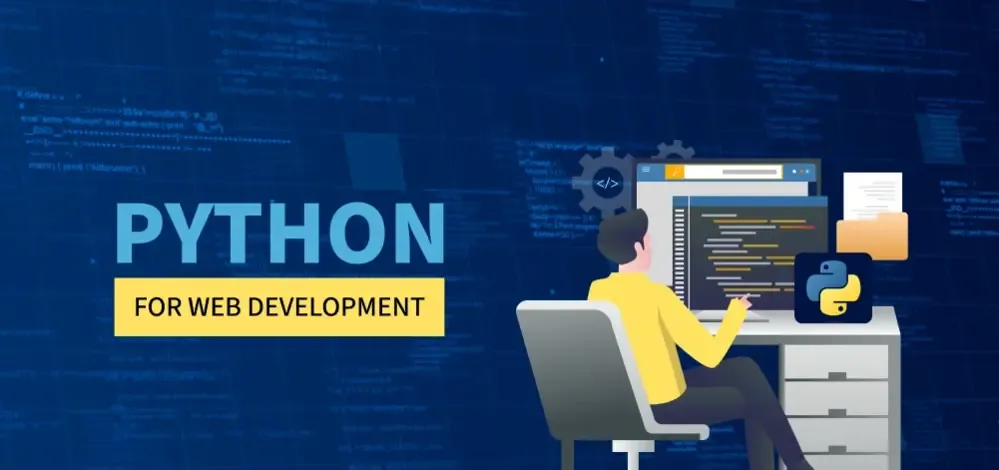Python for Web Development (original) (raw)
Last Updated : 21 Apr, 2025
To excel in web development with Python, you need to master key concepts, frameworks, tools, and deployment strategies. This comprehensive roadmap provides a **step-by-step approach to mastering Python web development. It covers everything from the fundamentals to advanced concepts like **API design, **security, **deployment, and **containerization.

By following this guide, you'll be well-equipped to build modern, scalable, and efficient web applications.
Python Basics
The foundation of **Python web development starts with understanding the core language features. Mastering Python basics, such as data types, control structures, functions, error handling, and object-oriented programming concepts, will ensure a smooth transition into web development. Python's simplicity and readability make it an excellent choice for beginners and experts alike.
- Getting Started with Python Programming
- Python syntax, data types, and variables
- Control structures (loops, conditionals)
- Functions, classes, and modules
- File handling
- Error handling (try/except)
- Python libraries and tools
Web Development Basics
Before diving into frameworks, it's important to understand web development fundamentals. This includes knowing how HTTP works (the communication protocol between servers and clients), understanding the client-server architecture, and how frontend technologies like HTML, CSS, and JavaScript interact with backend systems. Web development basics also cover concepts such as requests, responses, status codes, and headers, which are crucial when building dynamic websites.
Core Frameworks for Web Development
When it comes to building web applications with Python, choosing the right framework can significantly impact the scalability, performance, and maintainability of your project. There are several **Python frameworks available, each suited for different project types. Here’s an overview of the core frameworks you’ll need to master:
Django (For large projects and real-time applications)
- Introduction to Django
- Django Models
- Django Views
- Django URL Routing
- Django Templates
- Static and Media Files
- Forms & Input Handling
- Middleware
- Django ORM
- Django Admin
- Building RESTful APIs with Django
**Flask (For Small to Medium Projects)
- Introduction to Flask
- Flask Application Structure
- Routing and URL Management
- Request and Response Handling
- Flask Templates
- Authentication & Authorization
- Middleware & Extensions
- Form Validation
- Building REST APIs with Flask
**Fast API
- Introduction to Fast API
- Fast API Components
- Path Parameters
- Query Parameters
- Request Body and JSON
- Dependecies
- Response Models
- Validation with Pydantic
- HTTP Methods
- Dependency Injection
- Security and Authentication
- Integration with SQL Databases
- Intergration with NoSQL Databases
- Testing
Databases in Python Web Development
Databases are an integral part of web development, as they store and manage the data that web applications interact with. Whether you’re building a simple blog or a complex social media platform, understanding how to integrate and work with databases is crucial. In Python web development, databases are categorized into two types:
SQL
- **Django
- **Flask
- **FastAPI
- How to integrate MySql database with FastAPI?
- How to integrate PostgreSQL database with FastAPI?
**NOSQL
- **Django
- **Flask
- **FastAPI
Advanced Topics
REST API
**API Documentation
- Swagger
- POSTMAN
**Authentication and Security
- OAuth2, JWT, and Tokens
- Password hashing
- Session management
- Cross-Site Request Forgery (CSRF) prevention
Deployment
Once your application is ready, it needs to be deployed to a server where users can access it. This involves setting up cloud platforms like AWS, Google Cloud, or Azure to host your Python application. Deployment includes server setup, environment configuration, and ensuring that your application is accessible and scalable for users.
**Django
- Deployment of Django application in AWS EC2, Lambda
- Deployment of Django application in Azure
- Deployment of Django application in Google cloud
**Flask
- Deployment of Flask application in AWS EC2
- Deployment of Flask application in Google cloud
- Deployment of Flask application in Azure
Containerization
Containerization involves packaging applications and their dependencies into containers (using tools like Docker). Containers provide consistency across different environments, from development to production. Kubernetes is often used for orchestrating and scaling containerized applications. This approach helps in achieving portability and scalability.
- **Django
- **Flask
- **Fast API
- Containerize Fast api in Docker
- Containerize Fast api using Kubernetes.
Projects
Hands-on projects are essential to apply your knowledge and sharpen your skills. Working on real-world projects helps you understand how all the components (frameworks, databases, APIs) come together in an actual application. You can check some Project Ideas here:
- Django projects
- Flask projects
- Fast API projects